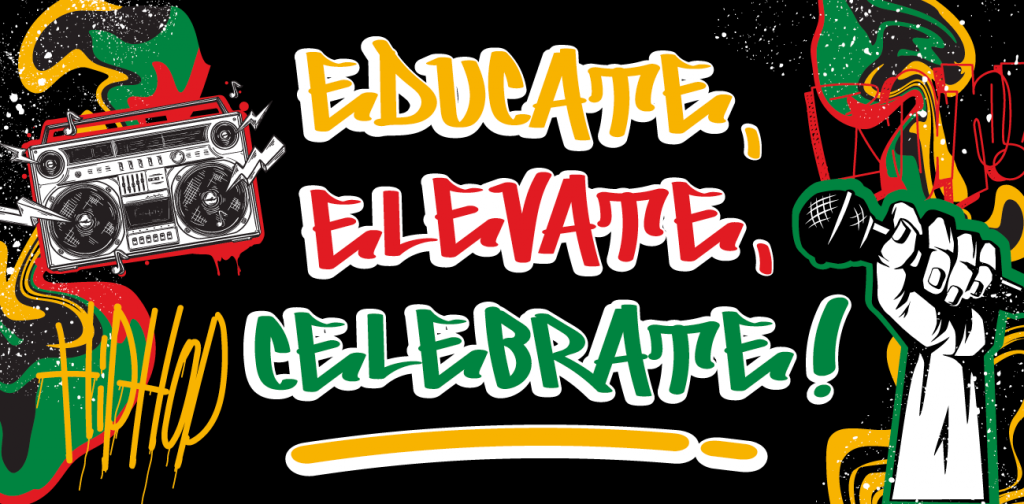Black History and Hip Hop Culture

Date: January 29, 2024
As hip hop evolves, it remains a dynamic force, responding to contemporary challenges and contributing to the ongoing fight for equality and justice. Incorporating hip hop into education around Black History Month provides an opportunity to explore the cultural richness, resilience, and artistic expressions within the Black community, fostering a deeper understanding of the interconnectedness of hip hop and Black history.
The Origins and Influences of Hip Hop
The origins of hip hop took root in the vibrant but economically distressed neighbourhoods of the South Bronx in the 1950s and 1960s. This period marked a tumultuous time for the community as they grappled with issues like poverty, racial segregation, and urban decay. Amid adversity, the South Bronx became a melting pot of cultures. African American, Caribbean, and Latinx communities converged, bringing a rich tapestry of traditions, languages, and musical influences.
This cultural fusion laid the groundwork for the birth of hip hop, as diverse communities sought creative outlets for expression. In this setting, block parties emerged as communal celebrations. DJs, like Kool Herc, began experimenting with turntables and mixers, extending the instrumental breaks of funk and soul records. These extended breaks became the foundation for MCs (Masters of Ceremonies) to showcase their rhythmic rhymes, marking the birth of hip hop’s DJing and MCing elements.
Simultaneously, the vibrant graffiti art scene in the South Bronx provided a visual language for self-expression. Artists used subway cars and city walls as canvases, turning an act of vandalism into a form of artistic rebellion. Graffiti, a significant element of hip hop culture, became a way to reclaim public spaces and communicate messages.
The streets of the South Bronx also witnessed the emergence of breaking (breakdancing). This new dance style began similarly to many dance styles—as a form of self-expression and liberation. Breakdancing took shape within communities experiencing both the strife and the desire to connect with others. With moves inspired by martial arts and athletic prowess, breaking provided a positive outlet for young people in the community, offering an alternative to the challenges they faced.
Classroom Activity Idea: Check out the timeline of hip hop from Carniage Hall here. To bring this historical context to life in the classroom, you can incorporate multimedia resources such as documentary clips, interviews with early hip hop pioneers, and visual representations of the South Bronx during this period. Students can engage in discussions about the social and economic challenges and explore the cultural fusion that occurred.
Learning Resource: #BlackMusicMatters: Hip Hop & Social Justice in Canada is a listening- and inquiry-based resource designed for teachers with students in grades 7-12. It is intended to be used by educators of various disciplines who wish to explore Black culture, history, and creation, specifically through the lens of hip hop music.
The Four Elements of Hip-Hop
1) MCing (Rapping): As hip hop emerged in the South Bronx, the art of MCing, or rapping, took centre stage. MCs were lyrical poets who narrated the realities of urban life, often improvising rhymes over the extended breaks created by DJs. This became a powerful means of storytelling, capturing the struggles, dreams, and aspirations of the community.
Classroom Activity Idea: Encourage students to explore the art of storytelling through rap. Provide historical context on early rap pioneers, such as Grandmaster Flash and The Furious Five or The Sugarhill Gang. Have students write their own rap verses, expressing their thoughts on personal experiences or social issues, connecting their creativity with the historical roots of MCing. Check out this step-by-step guide to writing a hip hop song from finding a theme and hook to writing strong lyrics.
2) DJing: DJing is a foundational element of hip hop culture. Early DJs, like Kool Herc, utilized two turntables and a mixer to extend instrumental breaks, creating a continuous beat for MCs to rhyme over. The DJ became a central figure in hip hop music, setting the stage for dance and lyrical expression.
Classroom Activity Idea: Introduce students to the basics of DJing by exploring the basic elements of musical beats, which involves a combination of rhythm, creativity and an understanding of musical elements. Provide opportunities for students to experiment with mixing beats, creating their own playlists, or even simulating a mini DJ battle in the classroom. Depending what you have available, you can use online platforms such as Soundtrap for Education, free mobile apps, or physical drum machines to bring this activity to life.
3) Breaking (Dance): Breaking, or breakdancing, emerged as a vibrant form of expression within the hip hop culture. Influenced by various dance styles, breaking became a physical manifestation of the beats and rhythms of hip hop music. It provided an outlet for creativity, self-expression, and community building. Did you know that breaking was added to the 2024 Summer Paris Olympics sports program?
Classroom Activity Idea: Add a little movement and creativity to your classroom by inviting students to explore the world of breaking. Introduce basic breaking moves, such as toprock, downrock, and freezes. Encourage them to choreograph short dance sequences individually or in groups, emphasizing the improvisational and creative aspects of breaking.
4) Graffiti Art: Graffiti art became an integral part of hip hop culture, serving as a visual form of expression in the urban landscape. Artists used vibrant colours, intricate lettering, and symbolic images to communicate messages, reclaim public spaces, and challenge societal norms.
Classroom Activity idea: Engage students in the world of graffiti art; ask them if they feel it’s art or vandalism and why. Explore the history of notable graffiti artists like Lady Pink or Dondi White. Provide a safe and creative space for students to design their own graffiti-inspired artwork, incorporating messages or symbols that hold personal or cultural significance.
The “Fifth Element”
The concept of the “fifth element” in hip hop, introduced by Afrika Bambaataa, extends beyond the traditional four elements of MCing, DJing, breaking, and graffiti art. Knowledge, as the fifth element, holds a pivotal role within hip hop culture, emphasizing a commitment to understanding the historical, cultural, and socio-political dimensions that shape the genre. It goes beyond the beats and rhymes, urging practitioners and enthusiasts to delve into their own identities, communities, and the broader context of hip hop’s emergence.
Knowledge in hip hop empowers individuals to seek education, engage in critical thinking, and become advocates for social justice. It encompasses the preservation of hip hop’s cultural legacy, emphasizing the importance of passing down knowledge to future generations. Moreover, knowledge extends globally, encouraging an awareness of not only local issues but also global challenges, fostering a sense of unity and interconnectedness within the hip hop community. The fifth element underscores the dynamic and evolving nature of hip hop, positioning it not only as a musical genre but as a cultural movement, deeply rooted in consciousness, continuous learning, and a commitment to positive growth.
Classroom Activity idea: Have students dissect their favourite hip hop songs and identify what the “fifth element” being presented is. What is the artist trying to say? What cultural or economic factors could be contributing to this message?
Evolution and Global Impact
While hip hop quickly gained traction in the United States, Canada had its own burgeoning hip hop scene. Early pioneers, like Maestro Fresh Wes, were instrumental in establishing a Canadian presence within the genre. Hip hop scenes flourished in cities across Canada, from Toronto to Vancouver, each contributing its own flavour and style to the Canadian hip hop mosaic. This period marked the formation of the foundation for a unique Canadian hip hop identity.
In the 21st century, Canadian hip hop artists achieved mainstream success both domestically and internationally. Artists like Drake, The Weeknd, and Tory Lanez brought Canadian hip hop to the global stage, showcasing the country’s diverse talent and cultural influence. Canadian hip hop has also been a vehicle for addressing social and political issues within the country. Artists have used their platforms to speak out against racial inequality, discrimination, and other social injustices, contributing to broader conversations about Canadian identity and multiculturalism.
Learning Resource: Check out this short doc by CBC on the origins and evolution of Canadian hip hop. Learn about the evolution across the globe here.
Indigenous Hip Hop
The transition of hip hop into Canadian Indigenous communities gained notable momentum in the 1990s and early 2000s, paralleling the broader growth of hip hop globally. This period coincided with a surge in cultural movements, including a reclamation of identity and the acknowledgment of the historical and ongoing struggles faced by Indigenous communities. In contrast to Black hip hop, which often addresses the African American experience of systemic racism, police brutality, and socio-economic challenges specific to the Black community, Indigenous hip hop delves into themes such as cultural reclamation, sovereignty, land rights, and the impacts of historical trauma.
One key aspect of Indigenous hip hop lies in the fusion of traditional elements with contemporary expressions. Indigenous hip hop often integrates traditional storytelling, oral histories, and languages into the lyrics, providing a unique lens through which to explore Indigenous experiences. This blending of cultural elements distinguishes Indigenous hip hop from its counterparts, fostering a distinct narrative that reflects the complex intersection of tradition and modernity.
Hip Hop as Critical Pedagogy (HHCP)
Hip Hop as Critical Pedagogy is an educational approach that leverages the elements of hip hop culture—such as rap music, DJing, breaking, graffiti art, and knowledge of self—as tools for critical thinking, empowerment, and social justice. This framework recognizes the cultural relevance and authenticity of hip hop in engaging learners, particularly those from diverse and marginalized backgrounds.
You can read more about the potential of this teaching framework and how schools in Canada are incorporating it into the classroom here. A great example of this in action was the 1995 film Dangerous Minds based off a true story where a teacher used rap lyrics to initiate poetry lessons.
Hip hop has become a global language of solidarity, connecting movements for Black rights around the world. Artists collaborate across borders, sharing common struggles and experiences. This global connectivity amplifies the impact of the Black movement and fosters a sense of unity on a global scale. By learning from hip hop, today’s youth can gain valuable insights into resilience, self-expression, community building, and social responsibility, contributing to their personal growth and the betterment of society. We encourage you to bring some of these activities into your classroom this Black History Month and all year round. To learn even more about hip hop, check out some of the films on this Rolling Stones List. Interested in taking your students on a tour to the birthplace of hip hop? Head to New York City with WorldStrides and engage in activities like graffiti tours and breaking workshops, in which they’ll dive into the past and present expressions of Black culture through different mediums. Reach out to us for more information!


